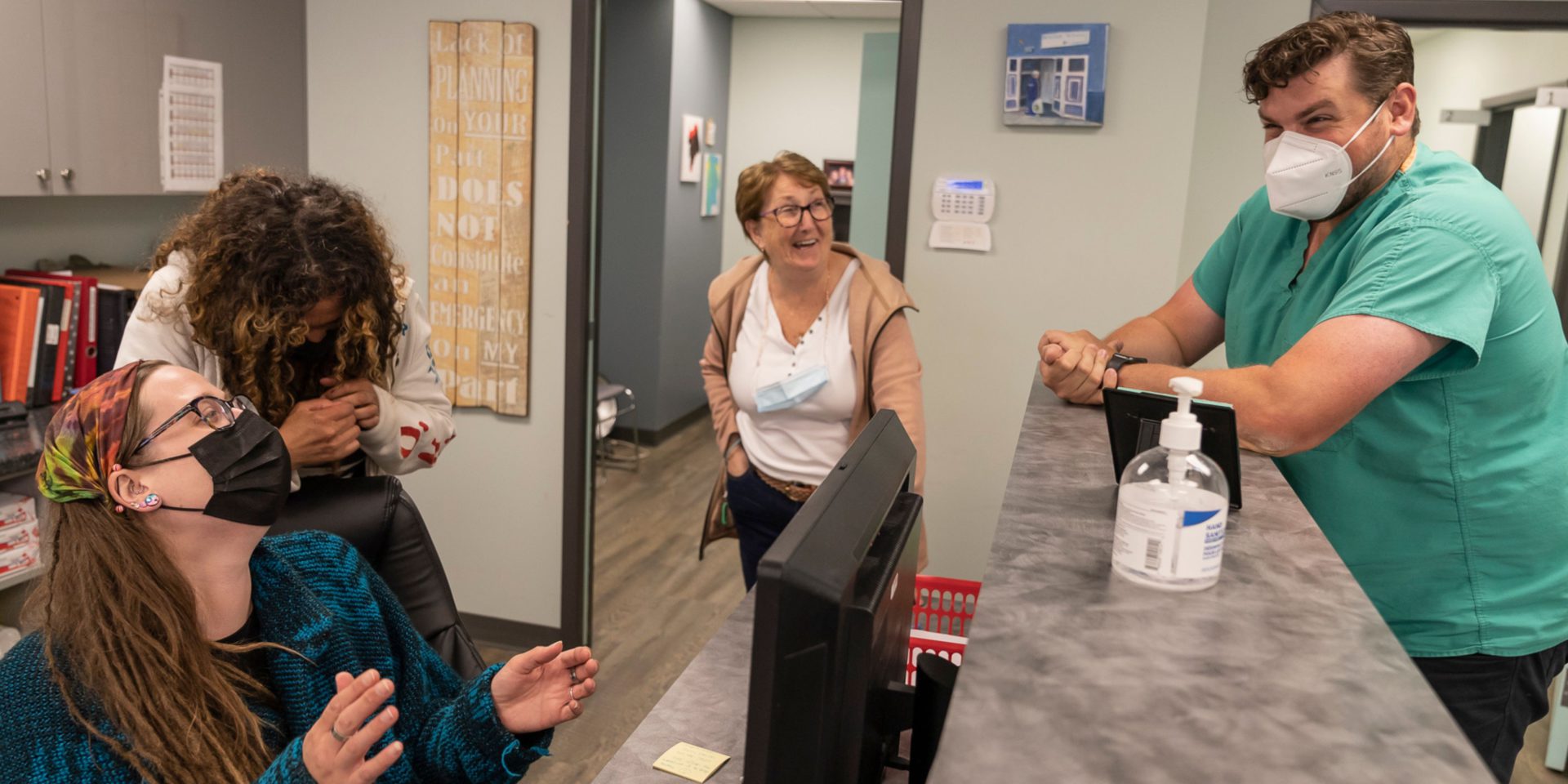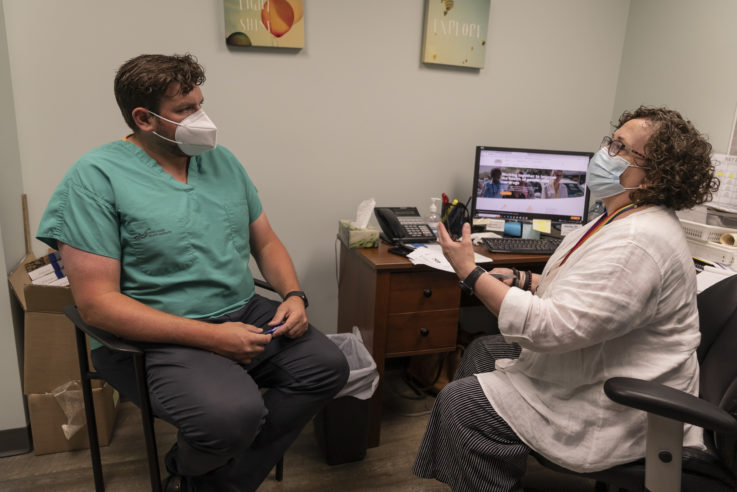Last modified: 27 June, 2023
Introduction
Send this intervention to your inbox
In this guide to auditing medical records for hepatitis C (HCV), we explore what a medical record audit is, look at potential barriers to data entry and how to overcome them, and provide detailed advice and guidance on how to implement an audit in your service. We’ll also give you some practical tools, tips and resources you can use to help you along the way.
The authors and reviewers of this guide include people with living experience of drug use or viral hepatitis, healthcare practitioners, researchers, laboratory scientists, policymakers and other service providers globally. This guide is part of our Intervention Toolkit, which profiles innovative models of HCV care and offers guidance on how to set up different interventions for HCV in your service.
Definition
In the simplest terms, a medical record audit is a chart review that allows you to identify what is being done well and what can be improved.
It is the process of searching medical records to identify clients with a particular condition or feature. These individuals may be at risk of a particular health issue or may need follow-up care or proactive care. A medical record audit is also commonly referred to as ‘case finding’ or a ‘clinical audit’. A medical record audit can be done by a third party or by staff within your service or organisation. Internal audits are most frequently used to evaluate current or existing processes or practice and to measure the quality of care being provided.
A medical record audit may be carried out using a variety of methods depending on the resources available to the practice. An audit can be paper-based or utilise practice management software. There are also data extraction and clinical audit software available , commonly through a third party.
How does medical record auditing work for HCV?
Medical record auditing allows a practice to recognise the features of its client base or practice population. Knowing the features of a group of patients allows the practice to target appropriate interventions to improve the health of individual patients.
There are many electronic record systems on the market and a range of data extraction tools available. The data extracted from the medical software system is very dependent upon the correct and consistent entry of clinical items entered by clinicians. However, whatever the system, the principle remains the same. A medical record audit identifies a particular condition or feature, searches each patient record for this feature, recalls the patients, provides the intervention and updates the medical record.
For example, a practice may choose to identify all the patients known to have a history of injecting drug use so that these patients can be recalled and offered screening or treatment for hepatitis c. The clinical files will be searched either manually or searching for coded entries or ‘key phrases’ to develop a list or register of people who are known to currently or previously inject drugs. Each of the files on this list or spreadsheet will be opened, and their hepatitis C status recorded on a list or register. Charts (clinical files) should be updated if the pulled data is not easily seen in the chart. Details or chart audits may include searching the clinical file for the following:
- Searching for the words ‘hepatitis C’
- Whether there are recorded HCV antibody tests
- HCV RNA test results (confirming current infection)
- The presence or otherwise of cirrhosis (APRI, FIB4, Fibroscan)
- Sustained Virological Response (SVR)
- Previous hepatitis C treatment or current hepatitis treatment.
These individuals would then be recalled (or perhaps a note placed on their file) for appropriate follow-up care.
If using clinical software, coded data entry is essential as entries using free text are challenging to search electronically.
Who should be involved?
It is important that for medical record auditing projects, the whole team is involved from the outset, in order to identify how client care can be improved and to support the ongoing implementation. All those for whom the audit may affect should be represented on the project team, including staff members from different care sectors to ensure a multi-disciplinary approach.
Engagement with people with a lived or living experience of hepatitis C is key to gain their views on how the audit should be implemented, what they would like to see from the service and potential avenues for improvement. Having the support of colleagues or upper management is crucial to ensuring that the results of the audit and required changes can be put into practice.
- Medical record auditing can help find people who have been lost to follow up on the HCV care cascade
- Medical record auditing can measure outcomes and performance of the practice and individual clinicians. It can improve the health of patients both on an individual and practice level
- It can help bring the need for HCV treatment to the forefront of the practitioner. With some clients having multiple major health challenges, HCV can be lost and not prioritised by the health care provider
- With the advent of Direct Acting Antivirals, it is now possible to eliminate hepatitis C from a practice or service. Medical record auditing is an important process to identify patients who would benefit from hepatitis treatment and record the number of people cured of hepatitis C
- It can help to demystify any beliefs about HCV and treatment
- Working on a medical record audit can create strong collaborative teams, rather than individuals working in silos
- It can help to prevent long-term medical complications of HCV, such as cirrhosis and liver cancer
- It can help highlight unconscious biases and stigma, particularly in relation to injecting drug use, ethnicity and culture
- An audit of the medical records can only be as good as the data entered into the records. It is essential that data is entered in a consistent and systematic way, particularly diagnoses and reason for visit, to allow optimal use of the software search functions
- The follow-up involved in a medical record audit can be time consuming and resource intensive, requiring appropriate consideration before commencing

There are several key steps involved in conducting a medical record audit at your service. There are a few factors to consider at each step, in order to tailor the audit, find the right information in your patient records or practice management software and manage the workload.
Identifying the group of patients requiring care is a good starting point around which you can build and refine your search.
Once you have conducted the search, you can create a list of patients in your clinic who require care and set about implementing a system to ensure they are followed up.
How to set up a medical record audit in your service
- Plan: Set your aim/s, objectives and the standards you will be measuring against. It is important that the audit is measurable based on the available data
- Establish standards: It’s important to establish standards that are grounded in the most robust and current evidence of best practice. If you’re using guidelines as a reference point, it’s advisable to rely on those that have the widest applicability, such as national guidelines, rather than those that are limited to a specific region or locality
- Conduct a literature review: In cases where there are no existing guidelines or the existing ones are outdated, you’ll need to conduct a thorough review of relevant literature to determine what the current best practices are.
- The target population will depend on your practice type, location, patient demographic
- You can choose to be specific or more general in your search, depending on the type of patients you are trying to reach
- Will you be searching electronic medical records or paper-based records?
- You may have several different target populations; it can be useful to prioritise these populations in order of urgency, so you don’t have an overwhelming workload. Make sure all involved in the audit at a service level understand the inclusion and exclusion criteria.
- Examples of populations could include:
- People with a positive hepatitis c antibody test
- People who have had a hepatitis C RNA test in the past
- People who inject drugs
- People on opioid agonist therapy (OAT)
- People who were born or who have lived in a high prevalence country
- People who have had blood transfusions in countries where transfused blood is not screened for hepatitis
- Or a specific age cohort, amongst other populations.
- It is important to remember that there may be some limitations in what information you can get from your Practice Management Software
- You may have to think creatively about your search terms and target population to create your list of people for follow up
Identify your patients
- Familiarise yourself with the search functions of the software used in your practice.
- Develop a register of patients to be recalled. A register is effectively a list so simple spreadsheet would suffice.
- It may be useful to review pathology results to identify people for recall. Practice Management Software search functions often have limited capacity to extract pathology results. Consider approaching the pathology providers who service your clinic as they may be able to provide patients level data on investigations and results
- There are data extraction systems, usually available from a third party. These are very useful for practice level data to measure outcomes.
Defining your search terms
- Common search terms:
- People with a diagnosis of hepatitis C (to find people who have been diagnosed but not yet treated) (searching up ‘Hepatitis C’ or ‘HCV’ or ‘Viral Hepatitis’ when doing a Conditions/Diagnosis/Clinical Items report)
- People with a positive hepatitis c antibody test (this may be tricky and there are a lot of factors– search up ‘Hepatitis’ when searching up in an Investigations’ report, then crosschecking whether results are a) reviewed b) unreviewed c) ordered but not received d) results received but not matched to a patient)
- People who have a positive hepatitis C RNA test (ribonucleic acid amplification test) (this may be tricky and there are a lot of confounding factors– search up ‘Hepatitis’ when searching up in an Investigations’ report, then crosschecking whether results are a) reviewed b) unreviewed c) ordered but not received d) results received but not matched to a patient)
- People who have a history of injecting drug use (searching up injecting drug use (IDU)/former IDU, polysubstance abuse/substance use/methamphetamine/ heroin/opioid use/ketamine when doing a Conditions/Diagnosis/Clinical Items report)
- People currently on Opioid Agonist Therapy (searching up ‘Methadone’, ‘Buprenorphine’, ‘Sublocade®’ ‘Buvidal®’ or other opioid agonist therapies when doing a ‘Medications’ report – making sure you capture those prescribed at the service and those prescribed elsewhere but then recorded in their Medication History.
- Children of people with hepatitis C (when you have made a register of clients with ‘Hepatitis C’ then there may be a way to filter by ‘Dependents’
- People born or who have lived in a country with high hepatitis C prevalence
- People in an age range cohort
- People who have had blood transfusions in countries where transfused blood is not screened for hepatitis C
- People who have had medical/dental procedures in countries that may have inadequate sterilisation
- People who have received unsterile tattoos or body art
- People with high liver enzymes
- People with a history of incarceration (independent risk factor in Australia)
- People who have been prescribed treatment for hepatitis C (to recall for SVR/look for reinfection)
- Practice management software search functions can be limited in what they are able to search for. You may have to rethink your target population in creative ways so you can search for them.
- You may need to change your search terms to increase or decrease the number of patients identified, based on your clinic’s capacity to follow these patients up
Helpful resources:
- Add patient specific detail to your list/register. Consider including details such as:
- Age
- Indigenous status
- Cultural background
- Hepatitis C antibody result
- Hepatitis C RNA result
- Hepatitis C genotype (no longer needed in some locations)
- APRI score (AST to Platelet Ratio index – freely available calculators are available that use the AST and platelet results to estimate the likelihood of cirrhosis)
- FIB 4 Score (uses a combination of patient age, platelet count, AST and ALT to help estimate the amount of scarring in the liver)
- Fibroscan score (liver elastography where available)
- Previous treatment
- SVR12
- Use your clinical judgement to decide the most appropriate care to offer the patient. It may be:
- Screening for hepatitis c infection according to risk factors. If you haven’t seen the patient in many years following up to see if the patient has been treated for HCV
- Treatment of hepatitis C due to known infection
- Follow up to ascertain SVR12
- Testing or treatment for reinfection
- Referral or management of advanced liver disease
- Hepatocellular carcinoma (HCC) surveillance
- Use existing systems within your practice to recall the client you have identified
- Consider SMS, email phone or letter to contact the patient to offer an appointment
- Leave a message at the patient’s pharmacy (or shelter or outreach worker) to call or come to the clinic
- Add a reminder in the client’s file to flag what needs to be discussed/offered at next visit.
Systems and Training
- It is ideal to develop a sustainable system within your practice that is not dependent on a single person.
- Ensure the whole team – doctors, nurses and support staff are aware of the process and have adequate training.
- Consider training in:
- Hepatitis C clinical management
- Stigma and Discrimination
- Cultural awareness
- The use of clinical software and coding clinical entries
- The use of data extraction software
- Consider sharing success stories at clinical meetings or team building days to create champions in the clinic
Role allocation
- Allocate who will do the work to recall the patients you have identified. It is important to have role allocation when conducting recalls of patients into your clinic and to ensure that the staff who have been tasked with conducting this task have time, skills and capacity to do so.
Managing the workload
- Organizing protected time away from usual duties for staff to conduct the recall can be helpful to ensure it can be done
- Assess the amount of follow-up to be done vs the staff capacity. You may need to scale your search terms up or down to make sure the workload remains manageable.
Communication
- It is vital that the whole team is aware of the process – from the person conducting the search, right through to the clinician who is ordering tests, prescribing treatment, or having a conversation with the patient
Clinical capacity
- Can your practice provide the care? Do all GPs and nurses in the clinic know how to manage someone with hepatitis C? Make sure that you have the clinical capacity to provide the follow-up care
Helpful resources:
Review the findings of the audit and identify the opportunities for quality improvement, using the findings to guide next steps. Summarising the findings is critical given disorganised or unnecessary data may result in an inability to use the results to enable change.
Reflect on how you will present the findings, summarising the data in a way which will be most impactful.
Helpful resources:

Search for online resources about your specific practice management software – the companies that provide the software often have training on how to use the search function.
Companies may also have a hotline you can call to talk through the process over the phone. They usually need your clinic ID or liscence number, so make sure you have this handy when you call.
Organizing protected time away from usual duties for staff to conduct the recall can be helpful to ensure it can all be done. Assess the amount of follow up to be done vs the staff capacity. You may need to scale your search terms up or down to make sure the workload remains manageable.
Clear role allocation for the different tasks involved. Who will conduct the recall for the clients you have identified. It is important to have role allocation when conducting recalls of patients into your clinic and to ensure that the staff who have been tasked with conducting this task have time, skills and capacity to do so.
Ensure staff have access to education and training as well as resources that ensure they have the skills and knowledge to provide care.
Can your practice provide the care? Do all GPs and nurses in the clinic know how to manage someone with hepatitis C? Make sure that you have the clinical capacity to provide the follow-up care required.
In some regions, government agencies, departments of health, health networks or national/state peak bodies will provide additional funding to clinics to conduct a quality improvement program.
It is worth looking into what financial incentives are available to your clinic before undertaking your project.
Utilise global best practice examples from services who have successfully implemented and undertaken auditing projects for hepatitis C as an evidence based to demonstrate efficacy.

What does the evidence say?
Title |
Author |
Year |
Link |
| A Digital Case-Finding Algorithm for Diagnosed but Untreated Hepatitis C: A Tool for Increasing Linkage to Treatment and Cure | Wyatt B, et al. | 2021 | Read the paper |
| Detection, stratification and treatment of hepatitis C–positive prisoners in the United Kingdom prison estate: Development of a pathway of care to facilitate the elimination of hepatitis C in a London prison | Connoley D, et al. | 2020 | Read the paper |
| Behavioral interventions to improve population health outreach for hepatitis C screening: randomized clinical trial | Mehta S, et al. | 2020 | Read the paper |
| Improving HCV Risk Assessment and Testing in a Federally Qualified Health Center Setting in Baltimore, Maryland | Layman R, et al. | 2020 | Read the paper |
| Improving the referral of hepatitis C virus positive patients to specialists through an electronic “pop-up” alert system | Sayar S, et al. | 2020 | Read the paper |
| Cost effectiveness of an intervention to increase uptake of hepatitis C virus testing and treatment (HepCATT): cluster randomised controlled trial in primary care | Roberts K, et al. | 2020 | Read the paper |
| Electronic medical record alert activation increase hepatitis C and HIV screening rates in primary care practices within a large healthcare system | Tapp H, et al. | 2020 | Read the paper |
| A Population‐Based Intervention to Improve Care Cascades of Patients With Hepatitis C Virus Infection | Scott J, et al. | 2020 | Read the paper |
| From emergency department automated hepatitis B & C screening to care and cure in a primary care practice | Wang S, et al. | 2020 | Read the paper |
| Predictive factors for not undergoing RNA testing in patients found to have hepatitis C serology and impact of an automatic alert | Morales‐Arraez D, et al. | 2019 | Read the paper |
| Hepatitis C Virus Screening and Care: Complexity of Implementation in Primary Care Practices Serving Disadvantaged Populations | Turner B, et al. | 2019 | Read the paper |
| Increased HCV Screening Yields Discordant Gains in Diagnoses Among Urban and Rural Veteran Populations in Texas: Results of a Statewide Quality Improvement Initiative | Wray D, et al. | 2019 | Read the paper |
| Increasing Birth Cohort Screening for Chronic Hepatitis C in a Primary Care Clinic with Panel Management | Balkissoon C, et al. | 2019 | Read the paper |
| A Program Of Hepatitis C Surveillance With Linkage To Care For Inpatients From Non-Infectious Departments In Two Tertiary Hospitals From Jiangsu, China | Chen Y, et al. | 2019 | Read the paper |
| Increase HCV Screening Utilizing Electronical Medical Records In A Family Practice Setting | Condon J. | 2019 | Read the paper |
| Doubling Hepatitis C Virus Screening in Primary Care Using Advanced Electronic Health Record Tools—A Non-Randomized Controlled Trial | Hojat L, et al. | 2019 | Read the paper |
| Evaluation of a Multifaceted Intervention to Reduce Health Disparities in Hepatitis C Screening: A Pre‐Post Analysis | Jain M, et al. | 2019 | Read the paper |
| Implementation and impact of clinical decision support (CDS) tool to increase hepatitis C virus (HCV) screening among baby boomers in a large urban health system | Armstrong H, et al. | 2018 | Read the paper |
| Implementation and Preliminary Results of an Emergency Department Nontargeted, Opt‐out Hepatitis C Virus Screening Program | Schechter‐Perkins E, et al. | 2018 | Read the paper |
| Impact of electronic reminder systems on hepatitis C screening in primary care | MacLean C, et al. | 2018 | Read the paper |
| An Intervention On Hepatitis C Screening At An Inner City Tertiary Care Center: A Quality Improvement Initiative | Parikh R, et al. | 2018 | Read the paper |
| A Comparative Effectiveness Study of Two Nontargeted HIV and Hepatitis C Virus Screening Algorithms in an Urban Emergency Department | White D, et al. | 2018 | Read the paper |
| Hepatitis C screening in commercially insured U.S. birth-cohort patients: Factors associated with testing and effect of an EMR-based screening alert | Yeboah-Korang A, et al. | 2018 | Read the paper |
| Impact of a hepatitis C virus electronic medical record screening alert for baby boomers | Teply R, et al. | 2018 | Read the paper |
| Hepatitis C virus testing for case identification in persons born during 1945‐1965: Results from three randomized controlled trials | Yartel A, et al. | 2018 | Read the paper |
| Electronic medical record alert improves HCV testing for baby boomers in primary care setting: adults born during 1945–1965 | Al-hihi E, et al. | 2017 | Read the paper |
| An Electronic Health Record–based Intervention to Promote Hepatitis C Virus Testing Among Adults Born Between 1945 and 1965 | Federman A, et al. | 2017 | Read the paper |
| Use of electronic health record clinical decision support tool for HCV birth cohort screening | Fitch D, et al. | 2017 | Read the paper |
| Impact of an Electronic Medical Record-Based System to Promote Human Immunodeficiency Virus/Hepatitis C Virus Screening in Public Hospital Primary Care Clinics | Goden M, et al. | 2017 | Read the paper |
| Improving Hepatitis C Identification: Technology Alone Is Not the Answer | Nitsche B et al. | 2017 | Read the paper |
| Impact of an electronic health record alert in primary care on increasing hepatitis C screening and curative treatment for baby boomers | Konerman M, et al. | 2017 | Read the paper |
| Impact of Screening Implementing HCV Screening of Persons Born 1945-1965 | Gemelas J, et al. | 2016 | Read the paper |
| Improving Hepatitis C Virus Screening Rates in Primary Care | Sidlow R, et al. | 2015 | Read the paper |
| Impact of electronic reminder to improve hepatitis C screening in age-appropriate patients: results of a pilot quality improvement intervention | Byrne T, et al. | 2014 | Read the paper |
Implementation theories:
Title |
Author |
Year |
Link |
| Making sense of implementation theories, models and frameworks | Nilsen, P | 2015 | Read the paper |
| A refined compilation of implementation strategies: results from the Expert Recommendations for Implementing Change (ERIC) project | Powell B, et al. | 2015 | Read the paper |
| Effective Practice and Organization of Care (EPOC) | Shepperd S, et al. | 2015 | Read the paper |










